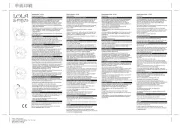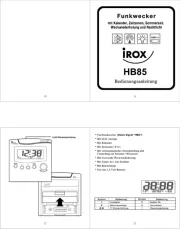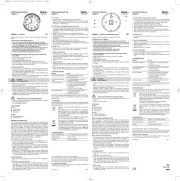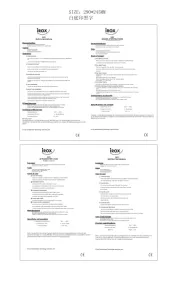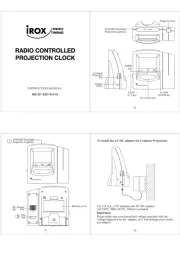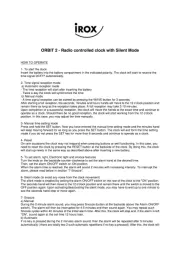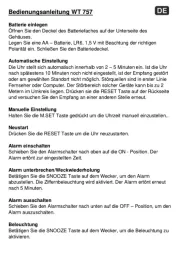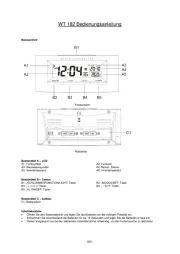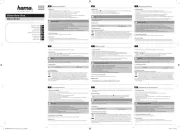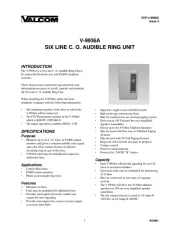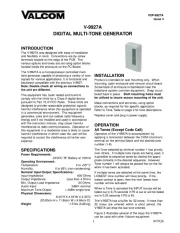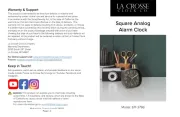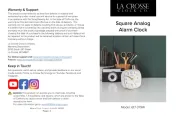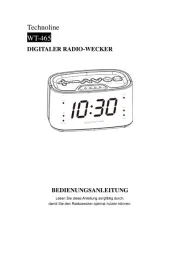
Vielen Dank, dass Sie sich für dieses IROX Gerät entschieden
1. Bevor Sie mit dem Gerät arbeiten
Lesen Sie sich bitte die Bedienungsanleitung genau durch.
Durch die Beachtung der Bedienungsanleitung vermeiden Sie
auch Beschädigungen des Gerätes und die Gefährdung Ihrer
gesetzlichen Mängelrechte durch Fehlgebrauch.
Für Schäden, die aus Nichtbeachtung dieser Bedienungsanlei-
tung verursacht werden, übernehmen wir keine Haftung.
Beachten Sie besonders die Sicherheitshinweise!
Bewahren Sie diese Bedienungsanleitung gut auf!
2. Einsatzbereich und alle Vorteile Ihres neuen Gerätes auf
Funkuhr mit leisem Sweep-Uhrwerk
• Gut ablesbares, großes Zifferblatt
• Sekundenzeiger – stoppt wenn die Batterie schwach wird
• Ideal für zuhause, das Büro, das Wartezimmer, den Eingangs-
oder Empfangsbereich und als Geschenk
Das Produkt ist ausschließlich für den oben beschriebenen Ein-
satzbereich geeignet. Verwenden Sie das Produkt nicht anders,
als in dieser Anleitung dargestellt wird.
Das eigenmächtige Reparieren, Umbauen oder Verändern des
Gerätes ist nicht gestattet.
Dieses Gerät ist nicht zur öffentlichen Information geeignet
und nur für den privaten Gebrauch bestimmt.
Bewahren Sie das Gerät und die Batterie außerhalb der Reich-
Batterien nicht ins Feuer werfen, kurzschließen, auseinander
nehmen oder aufladen. Explosionsgefahr!
Batterien enthalten gesundheitsschädliche Säuren. Um ein Aus-
laufen der Batterien zu vermeiden, sollten schwache Batterien
möglichst schnell ausgetauscht werden. Beim Hantieren mit
ausgelaufenen Batterien chemikalienbeständige Schutzhand-
schuhe und Schutzbrille tragen!
Wichtige Hinweise zur Produktsicherheit!
Setzen Sie das Gerät keinen extremen Temperaturen, Vibratio-
nen und Erschütterungen aus.
Vor Feuchtigkeit schützen.
Empfang der Funkzeit DCF:
Die Zeitübertragung erfolgt von einer Cäsium Atom-Funkuhr, die
von der Physikalisch Technischen Bundesanstalt in Braunschweig
betrieben wird. Die Abweichung beträgt weniger als 1 Sekunde in
einer Million Jahren. Die Zeit ist kodiert und wird von Main-
flingen in der Nähe von Frankfurt am Main durch ein DCF-77
(77,5 kHz) Frequenzsignal übertragen mit einer Reichweite von
ca. 1.500 km. Ihre Funkuhr empfängt das Signal, wandelt es um
und zeigt immer die exakte Zeit an. Auch die Umstellung von
Sommer- und Winterzeit erfolgt automatisch. Der Empfang hängt
hauptsächlich von der geographischen Lage ab. Im Normalfall
sollten innerhalb des Radius von 1.500 km ausgehend von Frank-
furt bei der Übertragung keine Probleme auftauchen.
Bitte beachten Sie folgende Hinweise:
Es wird empfohlen, einen Abstand von mindestens 1,5 – 2
Metern zu eventuell störenden Geräten wie Computerbildschir-
men und Fernsehgeräten einzuhalten.
In Stahlbetonbauten (Kellern, Aufbauten) ist das empfangene
Signal natürlicherweise schwächer. In Extremfällen wird emp-
fohlen, das Gerät in Fensternähe zu platzieren, um das Funk-
signal besser zu empfangen.
Nachts sind die atmosphärischen Störungen meist geringer und
ein Empfang ist in den meisten Fällen möglich. Ein einziger
Empfang pro Tag genügt, um die Genauigkeit zu gewährleisten
und Abweichungen unter 1 Sekunde zu halten.
Legen Sie eine neue Batterie 1,5 V AA ein, +/- Pol wie abgebil-
Das Gerät ist jetzt betriebsbereit.
Die Zeiger stellen sich auf 12 h und die Uhr versucht nun, das
Funksignal 3 – 12 Minuten lang zu empfangen. Wenn der Zeit-
code empfangen wurde, wird die funkgesteuerte Zeit ange-
zeigt. Die Funkuhr empfängt zweimal am Tag (1:00 und 3:00
Uhr morgens) das Signal. Während des Empfangs bleibt der
Sekundenzeiger auf 12 h stehen.
Sie können die Initialisierung auch manuell starten.
Drücken Sie für 3 Sekunden die REC Taste. Der Sekundenzeiger
bleibt auf 12 h stehen und die Funkuhr versucht nun, die Funk-
zeit erneut zu empfangen.
5.2 M SET Taste - Manuelle Einstellung der Uhrzeit
Falls die Funkuhr kein DCF-Signal empfangen kann (z.B. wegen
Störungen, Übertragungsdistanz, etc.), kann die Zeit manuell
eingestellt werden. Die Uhr arbeitet dann wie eine normale
Halten Sie die M SET Taste für drei Sekunden gedrückt
Halten Sie nun die M SET Taste gedrückt, bis die aktuelle Uhr-
Drücken Sie die M SET Taste nur kurz, rückt der Zeiger eine
Der Sekundenzeiger bleibt auf 12 Uhr stehen.
Nach 15 Sekunden bewegt sich der Sekundenzeiger weiter.
Bei erfolgreichem Empfang des DCF-Signals wird die manuell
eingestellte Zeit überschrieben
Drücken Sie die RESET Taste mit einem spitzen Gegenstand,
wenn die Funkuhr nicht einwandfrei funktioniert.
Reinigen Sie das Gerät mit einem weichen, leicht feuchten
Tuch. Keine Scheuer- oder Lösungsmittel verwenden!
Entfernen Sie die Batterie, wenn Sie das Gerät längere Zeit
Bewahren Sie Ihr Gerät an einem trockenen Platz auf.
Sobald die Funktionen schwächer werden und wenn der Sekun-
denzeiger auf 12 h stehen bleibt, wechseln Sie bitte die Batte-
Legen Sie eine neue Batterie 1,5 V AA in das Batteriefach. Ach-
ten Sie auf die richtige Polarität beim Einlegen der Batterie.
Keine Zeigerbewegung ➜ Batterie polrichtig einlegen
Sekundenzeiger bleibt Funksignalempfang abwarten➜
stehen Batterie wechseln➜
Kein DCF Empfang ➜ REC Taste für 3 Sekunden drücken
➜ Standort wechseln (Störfaktoren)
➜ Empfangsversuch in der Nacht
➜ Uhrzeit manuell einstellen
Unkorrekte Anzeige RESET Taste mit einem spitzen ➜
Wenn Ihr Gerät trotz dieser Maßnahmen immer noch nicht funktio-
niert, wenden Sie sich an den Händler, bei dem Sie das Produkt
Dieses Produkt wurde unter Verwendung hochwertiger Materia-
lien und Bestandteile hergestellt, die recycelt und wiederverwen-
Batterien und Akkus dürfen keinesfalls in den Haus-
Als Verbraucher sind Sie gesetzlich verpflichtet,
gebrauchte Batterien und Akkus zur umweltgerech-
ten Entsorgung beim Handel oder entsprechenden
Sammelstellen gemäß nationaler oder lokaler Bestim-
Die Bezeichnungen für enthaltene Schwermetalle
sind: Cd=Cadmium, Hg=Quecksilber, Pb=Blei
Dieses Gerät ist entsprechend der EU-Richtlinie über
die Entsorgung von Elektro- und Elektronik-Altgerä-
ten (WEEE) gekennzeichnet.
Dieses Produkt darf nicht mit dem Hausmüll entsorgt
werden. Der Nutzer ist verpflichtet, das Altgerät zur
umweltgerechten Entsorgung bei einer ausgewiese-
nen Annahmestelle für die Entsorgung von Elektro-
und Elektronikgeräten abzugeben.
Spannungsversorgung: 1 x 1,5V AA Batterie (nicht inklusive)
Gehäusemaße: Ø 305 x 45 mm
Gewicht: 762 g (nur Gerät)
OS Technology AG/SA · Dorfstr. 73 · CH-3073 Gümligen
Die technischen Daten entsprechen dem Stand bei Drucklegung und können
ohne vorherige Benachrichtigung geändert werden. Die neuesten techni-
schen Daten und Informationen zu Ihrem Produkt finden Sie unter Eingabe
der Artikel-Nummer auf unserer Homepage.
Wir erklären hiermit, dass diese Funkanlage die wesentlichen Anforderungen
der R&TTE Direktive 1999/5/EG erfüllt.
LUNA5-2 – Radio controlled wall clock
Thank you for choosing this instrument from IROX.
1. Before you start using it
Please make sure to read the instruction manual carefully.
Following and respecting the instruction of your manual will
prevent damage to your instrument and loss of your statutory
rights arising from defects due to incorrect use.
We shall not be liable for any damage occurring as a result of
not following these instructions.
Please take particular note of the safety advice!
Please keep this manual for future reference.
2. Field of operation and the benefits of your new instru-
Radio-controlled clock with silent “Sweep” movement
Second hand – stops when the battery is weak
Ideal for home, office, waiting room, lobby or entrance hall or
This product is exclusively intended for the field of application
described above. It should only be used as described in your
Unauthorised repairs, modifications or changes to the product
This product is not to be used for public information; it is only
Keep this instrument and the battery out of the reach of child-
Batteries must not be thrown into a fire, short-circuited, taken
apart or recharged. Risk of explosion!
Batteries contain harmful acids. Low batteries should be
changed as soon as possible to prevent damage caused leaking.
Wear chemical-resistant protective gloves and glasses when
handling leaking batteries.
Important information on product safety!
Do not place the unit near extreme temperatures, vibration or
Protect it from moisture.
Note for radio-controlled time DCF:
The time base for the radio-controlled time is a caesium atomic
clock operated by the Physikalisch Technische Bundesanstalt
Braunschweig. It has a time deviation of less than one second in
one million years. The time is coded and transmitted from Main-
flingen near Frankfurt via frequency signal DCF-77 (77.5 kHz) and
has a transmitting range of approximately 1,500 km. Your radio-
controlled clock receives this signal and converts it to show the
precise time. Changeover from summer time or winter time is
automatic. The quality of the reception depends mainly on the
geographic location. Normally there should be no reception prob-
lems within a 1,500 km radius around Frankfurt.
Please take note of the following:
The recommended distance from any interfering sources like
computer monitors or TV sets is a minimum of 1.5 - 2 meters.
Within Ferro-concrete rooms (basements, superstructures), the
received signal is naturally weakened. In extreme cases, please
place the unit close to a window.
During night-time, the atmospheric disturbances are usually
less severe and reception is possible in most cases. A single daily
reception is adequate to keep the accuracy deviation below 1
Insert one new battery AA size 1.5 V with the polarity as indi-
Your clock is now ready to use.
After the initial setup, the pointers move to 12 o’clock and will
try to receive the radio signal for 3-12 minutes. When the time
code is received, the radio-controlled time will be shown. The
clock receives the signal twice a day (1:00 and 3:00 am). During
the reception the second hand stops at 12 h.
Manual initialization can be helpful. Press the REC button for
3 seconds. The second hand stops and the clock will scan the
- Manual setting of clock
In case the clock cannot detect the DCF-signal (for example due
to disturbances, transmitting distance, etc.) the time can be set
manually. The clock will then work as a normal quartz clock.
Press and hold M SET button for three seconds.
Hold the button until the desired time is indicated.
Press the button briefly the pointer moves minute by minute.
The second hand stops at 12 o’clock.
After 15 seconds the second pointer is moving forward again.
The manually set time will be overwritten by the DCF time
when the signal is received successfully.
Use a pin to press the RESET button if the unit does not work
Clean your instrument with a soft damp cloth. Do not use sol-
vents or scouring agents.
Remove the battery if you do not use the product for a long
Keep your clock in a dry place.
Change the batteries when the functions of the instrument
become weak and the second hand stops at 12h.
Insert a new battery 1,5 V AA. Make sure the polarities are cor-
No pointer movement ➜ Ensure that the battery polarity is
No movement of the Wait for the reception of the radio-➜
second pointer controlled time
No DCF reception Press the REC button for 3 seconds➜
➜Change location (interference!)
➜ Wait for attempted reception
Incorrect display Press the RESET button with a pin➜
If your device fails to work despite these measures contact the sup-
plier from whom you purchased it.
This product has been manufactured using high-grade materials
and components which can be recycled and reused.
Never dispose of empty batteries and rechargeable
batteries in household waste.
As a consumer, you are legally required to take them
to your retail store or to an appropriate collection site
depending on national or local regulations in order to
The symbols for the heavy metals contained are:
Cd=cadmium, Hg=mercury, Pb=lead
This instrument is labelled in accordance with the EU
Waste Electrical and Electronic Equipment Directive
Please do not dispose of this instrument in household
waste. The user is obligated to take end-of-life
devices to a designated collection point for the dis-
posal of electrical and electronic equipment, in order
to ensure environmentally-compatible disposal.
Power consumption: Battery 1.5 V AA (not included)
Housing dimension: Ø 305 x 45 mm
Weight: 762 g (instrument only)
OS Technology AG/SA · Dorfstr. 73 · CH-3073 Gümligen
The technical data are correct at the time of going to print and may change
without prior notice. The latest technical data and information about your
product can be found by entering your product number on our homepage.
DECLARATION OF CONFORMITY
Herewith we declare, that this wireless transmission device does comply with
the essentials requirements of R&TTE Directive 1999/5/EC.
IROX_No. 60.3517_Anl_08_14 28.07.2014 10:20 Uhr Seite 1
